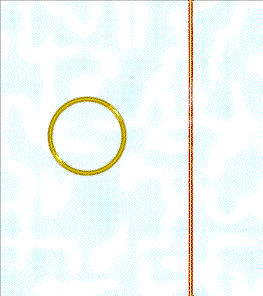 This Week's Puzzle
This Week's Puzzle
This assignment is due before 9 AM, Friday, November 10th, 2000.
- Puzzle solutions are due by 9:00 AM on Friday of each week.
- Puzzles are worth 5 points of extra credit each.
- Answers must be accompanied by valid reasoning. Just like the tests, the answer alone isn't enough!
- Each week, the first student to submit a correct answer will recieve the stylish
251 T-shirt.
- Previous winners get a "virtual t-shirt." No shirt, but a chance to win a prize with actual value at the end of the semester (often a book, or maybe software).
- Please enter your solution in the text area at the bottom of this page. DON'T FORGET TO GIVE YOUR NAME!
"Hoop, Line and Stinker"
 The figure shows an insulating ring and an infinite straight wire resting on the surface of an infinite plane. The wire is fixed in position, but the ring slides without friction on the surface of the plane. The ring is uniformly charged, with net positive charge Q. Initially, the wire carries a constant current I towards the top of the figure, and the ring is stationary. At time t=0, the current in the wire is reduced to I/2. Which of the following best describes the motion of the ring after the current is reduced?
The figure shows an insulating ring and an infinite straight wire resting on the surface of an infinite plane. The wire is fixed in position, but the ring slides without friction on the surface of the plane. The ring is uniformly charged, with net positive charge Q. Initially, the wire carries a constant current I towards the top of the figure, and the ring is stationary. At time t=0, the current in the wire is reduced to I/2. Which of the following best describes the motion of the ring after the current is reduced?
- The ring will spin clockwise and slide away from the wire.
- The ring will spin clockwise and slide towards the wire.
- The ring will spin clockwise and remain stationary.
- The ring will not spin, but it will slide towards the wire.
- The ring will spin counterclockwise and slide towards the wire.
- The ring will spin counterclockwise and remain stationary.
- The ring will not spin, but it will slide away from the wire.
- The ring will spin clockwise and slide towards the top of the figure.
- The ring will spin counterclockwise and slide towards the top of the figure.
- The ring will not spin, but it will slide towards the bottom of the figure.
- None of the above (please describe what does happen).
Hint: If an induced electric field can make current move, it can also apply a force to a charge on an insulator.
Don't forget to explain your answer as clearly as possible.
This site is made possible by funding from the National Science Foundation (DUE-9981111).
©2000 IUPUI, all rights reserved.
©2001 A. Gavrin and G. Novak, all rights reserved.
|



 This Week's Puzzle
This Week's Puzzle
